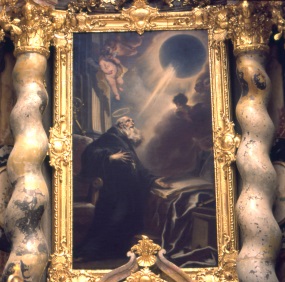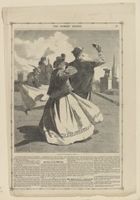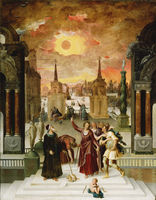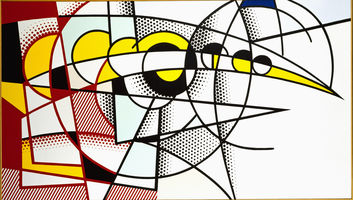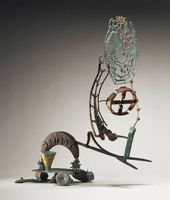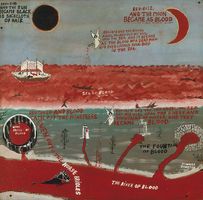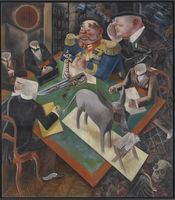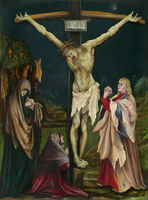Vision of St. Benedict
Cosmas Damian Asam Bavarian, 1686–1739
Vision of St. Benedict, 1735
Oil on canvas
Benediktiner-Kloster-und Pfarrkirche Sankt Georg und Sankt Martin, Weltenburg, Germany
In early eighteenth-century Bavaria, Cosmas Damian Asam combined novel scientific discoveries about solar eclipses with his own observations to create depictions of the Vision of St. Benedict. He began tentatively, inserting images of eclipses into other scenes, like the Crucifixion, and various events in the saint’s life, such as his apotheosis. Asam painted his 1726 Vision of St. Benedict (fig. 1) after experiencing the solar eclipse of May 22, 1724 (fig. 2). Although solar eclipses were not closely studied until the nineteenth century, with the Enlightenment came an ability to predict and calculate their paths (fig. 3). By portraying a solar eclipse as a metaphor for the saint’s vision, Asam made the religious experience more accessible. A reading of its literary source, the Dialogues of St. Gregory the Great, reveals why the event is rarely depicted: it was extremely difficult to visualize.
Around ten years later, Asam painted another galvanizing Vision of St Benedict, for a different Benedictine church. This painting represents the culmination of his desire to capture the saint’s ecstatic, mystical vision in naturalistic terms, via light that is a metaphor for the divine presence. The canvas shows an elderly saint who, confronted by a solar eclipse, seems to experience a seizure—as well as enlightenment—at the moment when light erupts from the celestial sphere, as described in Benedict’s vision. The artist accurately depicted the solar corona surrounding the moon, which is obscured by the sun as well as by the light that bursts forth from the edge of the dark lunar disk in the moment after totality. This phenomenon—when the first ray of light breaks through a valley on the edge of the moon’s silhouette—is known as the “diamond-ring effect” (fig. 4). Comparing this later representation with his earlier attempt (fig. 1) suggests that Asam witnessed the eclipse of May 13, 1733, and perhaps combined his own observations of it with descriptions from contemporary scientists.
Asam’s highly visionary, operatic art utilized light—both physical (natural light, sometimes via concealed architectural windows) and illusionistic—together with images of meteorological and astronomical phenomena, to create painted visions that were physically tangible. Like other artists interested in celestial observations, he depicted many astronomical and meteorological phenomena, among them stars, suns, lunar eclipses, rainbows, lightning, dramatically illuminated sunsets, and tempestuous skies, as well as an armillary sphere. Asam probably was not in touch with astronomers in the geographical areas where he worked. Nevertheless, before the advent of photography, astronomers, like artists, drew what they observed in the heavens.
For more information on this topic, see Roberta J. M. Olson and Jay M. Pasachoff, “St. Benedict Sees the Light: Asam’s Solar Eclipses as Metaphor,” Religion and the Arts 11 (2007): 299–329.
Roberta J. M. Olson, curator of drawings, New-York Historical Society
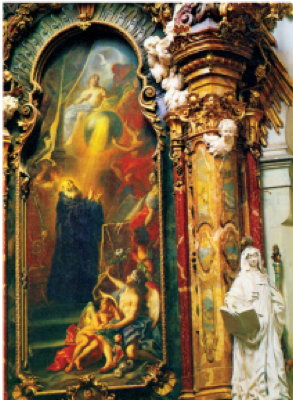


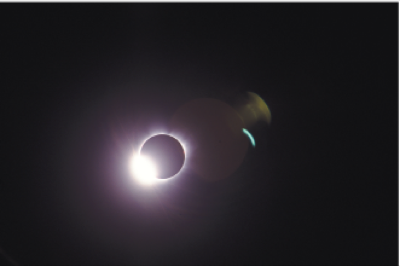
Roberta J. M. Olson, Curator of Drawings at the New-York Historical Society
